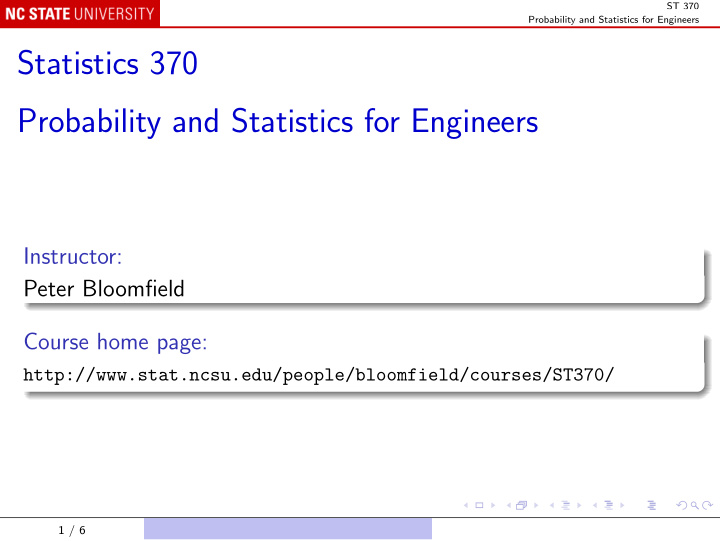



ST 370 Probability and Statistics for Engineers Statistics 370 Probability and Statistics for Engineers Instructor: Peter Bloomfield Course home page: http://www.stat.ncsu.edu/people/bloomfield/courses/ST370/ 1 / 6
ST 370 Probability and Statistics for Engineers Introduction “Statistics is a science that helps us make decisions and draw conclusions in the presence of variability.” Example: Transportation planning A transportation engineer planning a transportation system may need to predict the number of trips made each day in a given community, knowing: number of households; number of vehicles per household; number of adults and children per household. 2 / 6 The Role of Statistics in Engineering The Engineering Method and Statistical Thinking
ST 370 Probability and Statistics for Engineers Example: Transportation planning (continued) A sample of households fill out a questionnaire, with that information and their actual number of trips in a given week. The responses are variable : identical households may report a wide variety of numbers of trips. The engineer uses the responses from the sample to construct a regression model , which can then be used to make predictions for the whole community. A different sample would give a different collection of responses, hence different predictions; we need to describe how the variability in the responses leads to uncertainty in the model and its predictions. 3 / 6 The Role of Statistics in Engineering The Engineering Method and Statistical Thinking
ST 370 Probability and Statistics for Engineers The Engineering Method and Statistical Thinking Steps in the Engineering Method Describe the problem clearly and concisely. 1 Identify factors that may play a role. 2 Propose a model, incorporating any relevant scientific 3 knowledge. Carry out experiments to calibrate and test the model. 4 Repeat steps 2, 3, and 4 until the model is satisfactory. 5 Use the model to propose a solution to the problem. 6 Carry out experiments to verify that the proposed solution is 7 effective and efficient. Draw conclusions and make recommendations. 8 4 / 6 The Role of Statistics in Engineering The Engineering Method and Statistical Thinking
ST 370 Probability and Statistics for Engineers Example: Nylon connector How does the design of a nylon connector affect its “pull-off” force? 32 inch and 1 3 Engineer considers wall thicknesses of 8 inch; 8 prototypes fabricated at each thickness; 3 measured pull-off forces (lb f ) at 32 inch are 12 . 6 , 12 . 9 , 13 . 4 , 12 . 3 , 13 . 6 , 13 . 5 , 12 . 6 , 13 . 1; measured pull-off forces at 1 8 inch are 12 . 9 , 13 . 7 , 12 . 8 , 13 . 9 , 14 . 2 , 13 . 2 , 13 . 5 , 13 . 1. What can the engineer conclude? 5 / 6 The Role of Statistics in Engineering The Engineering Method and Statistical Thinking
ST 370 Probability and Statistics for Engineers Example: Nylon connector (continued) In R: nylonConnector <- read.csv("Data/nylon-connector.csv") # dot diagram: plot(Force ~ Thickness, nylonConnector) # box-and-whisker plot: plot(Force ~ factor(Thickness), nylonConnector) # fit a model: summary(lm(Force ~ factor(Thickness), nylonConnector)) The mean pull-off force increases by 0 . 4 lb f when the wall thickness increases from its low level to its high level. The variability in measured force and the small sample size mean that the increase is not statistically significant . 6 / 6 The Role of Statistics in Engineering The Engineering Method and Statistical Thinking
Recommend
More recommend